JavaScript_course
Accessing elements
DOM queries may return one element, or they may return a Node list, which is a collection of nodes.
getElementById(‘id’)
Selects an individual element given the value of its id attribute. The HTML must have an id attribute in order for it to be selectable.
First supported: IE5.5, Opera 7, all versions of Chrome, Firefox, Safari.
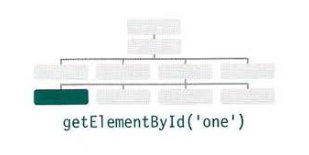
querySelector(‘CSS SELECTOR’)
Uses CSS selector syntax t hat would select one or more elements . This method returns only the first of the matching elements.
First supported: IE8, Firefox 3.5, Safari 4 . Chrome 4, Opera 10
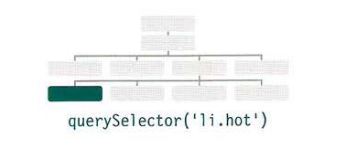
METHO DS THAT RETURN ONE OR MORE ELEMENTS (AS A NODE LIST):
getElementsByClassName(‘CLASS NAME’)
Selects one or more elements given the value of their class attribute. he HTML must have a class attribute for it to be selectable. This method is faster than querySelectorAll().
First supported: IE9, Firefox 3, Safari 4 , Chrome 4 , Opera 10 (Several browsers had partial I buggy support in earlier versions)
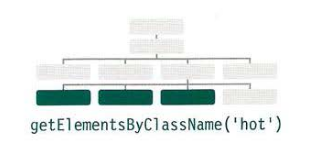
getElementsByTagName(‘HTML TAG NAME’)
Selects all elements on the page with the specified tag name. This method is faster than querySelectorAll().
First supported: IE6+, Firefox 3, Safari 4, Chrome, Opera 10 (Several browsers had partial I buggy support in earlier versions)
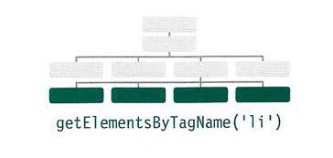
querySelectorAll(‘CSS SELECTOR’)
Uses CSS selector syntax to select one or more element s and returns all of those t hat match.
First supported: IE8, Firefox 3.5, Safa ri 4, Chrome 4, Opera 10

SELECTING ELEMENTS USING ID ATTRIBUTES
Let us see the following example found in Chapter_05/Examples/c05/get-elements-by-id.html
<h1 id="header">List King</h1>
<h2>Buy groceries</h2>
<ul>
<li id="one" class="hot">
<em>fresh</em>figs
</li>
<li id="two" class="hot">pine nuts</li>
<li id="three" class="hot">honey</li>
<li id="four">balsamic vinegar</li>
</ul>
// Select the element and store it in a variable.
var el = document.getElementById("one");
// Change the value of the class attribute.
el.className = "cool";
NODELISTS: DOM QUERIES THAT RETURN MORE THAN ONE ELEMENT
When a DOM method can return more than one element, it returns a Nodelist (even if it only finds one matching element).
“Nodelists look like arrays and are numbered like arrays, but they are not act actually arrays, they are a type of object called a collection.”
-
When a DOM query returns a Nodelist, you may want to:
- Select one element from the NodeList.
- Loop through each item in the Nodelist and perform the same statements on each of the element nodes.
-
Like any other object, a Nodelist has properties and methods, notably:
- The
lengthproperty tells you how many it items are in the Nodelist. - The
item()method returns a specific node from the Nodelist when you tell it the index number of the item t hat you want (in the parentheses).
- The
Selecting an element from Nodelist
There are two ways to select element from NodeList:
- Using
item()method - Array syntax.
Both require the index number of the element you want.
Using item() method
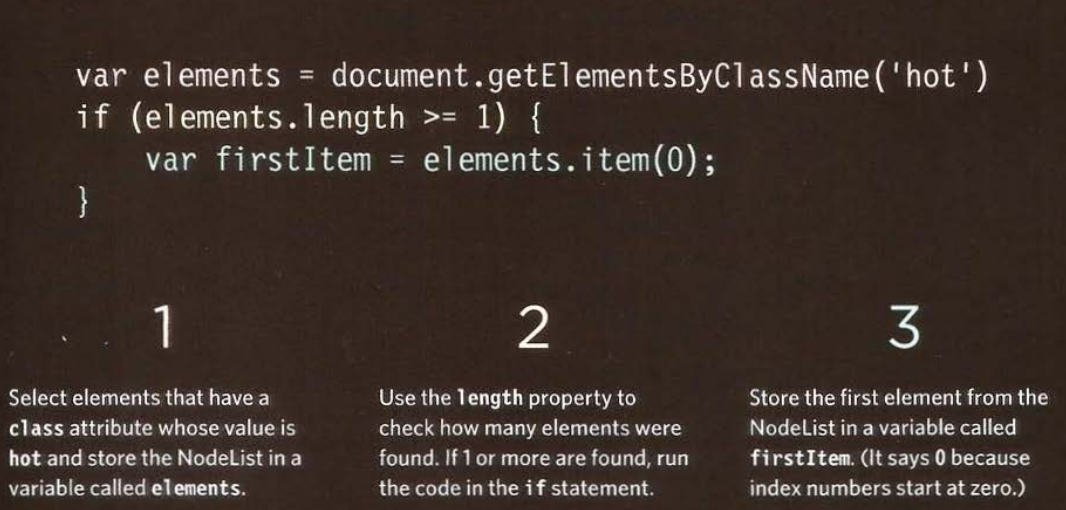
Note that:
- Array syntax is preferred over the item() method because it is faster.
- Before selecting a node from a NodeList, check that it containes nodes.
- If you repeatedly use the NodeList, store them in a
variable.
Using array syntax
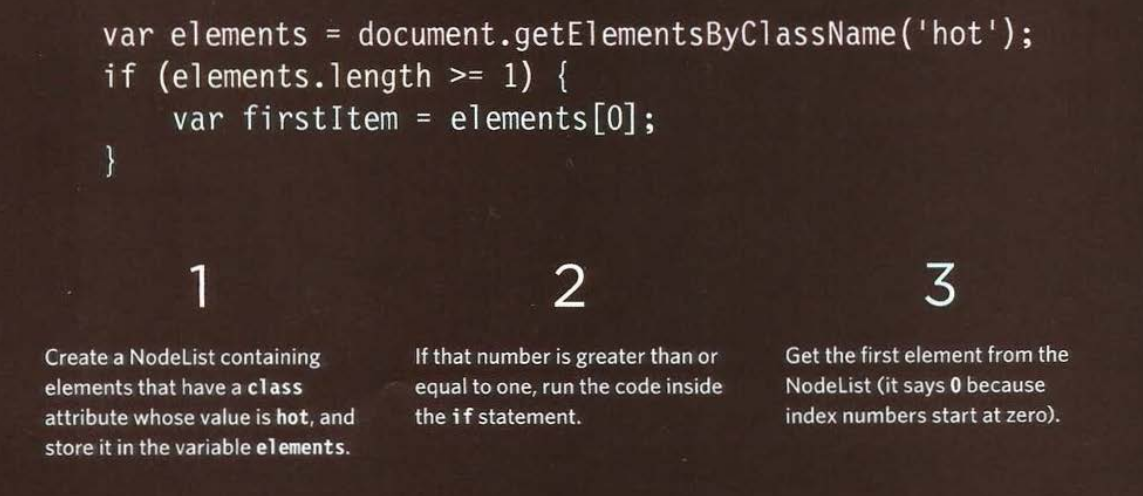
Examples
Here we have HTML and CSS:
HTML
<!DOCTYPE html>
<html>
<head>
<title>JavaScript & jQuery - Chapter 5: Document Object Model - Get Elements By Class Name</title>
<meta name="viewport" content="width=device-width, initial-scale=1.0">
<link rel="stylesheet" href="css/c05.css">
</head>
<body>
<div id="page">
<h1 id="header">List</h1>
<h2>Buy groceries</h2>
<ul>
<li id="one" class="hot"><em>fresh</em> figs</li>
<li id="two" class="hot">pine nuts</li>
<li id="three" class="hot">honey</li>
<li id="four">balsamic vinegar</li>
</ul>
</div>
<script src="js/get-elements-by-class-name.js"></script>
</body>
</html>
CSS
@import url(http://fonts.googleapis.com/css?family=Oswald);
body {
background-color: #000;
font-family: "Oswald", "Futura", sans-serif;
margin: 0px;
padding: 0px;
}
#page {
background-color: #403c3b;
margin: 0px auto 0px auto;
}
/* Responsive page rules at bottom of style sheet */
h1 {
background-image: url(../images/kinglogo.png);
background-repeat: no-repeat;
background-position: center center;
text-align: center;
text-indent: -1000%;
height: 75px;
line-height: 75px;
width: 117px;
margin: 0px auto 0px auto;
padding: 30px 10px 20px 10px;
}
h2 {
color: #fff;
font-size: 24px;
font-weight: normal;
text-align: center;
text-transform: uppercase;
letter-spacing: 0.2em;
margin: 0px 0px 23px 0px;
}
h2 span {
border-radius: 50%;
background-color: #000;
font-size: 10px;
text-align: center;
display: inline-block;
position: relative;
top: -5px;
height: 18px;
width: 20px;
margin-left: 5px;
padding: 4px 0px 0px 4px;
}
ul {
background-color: #584f4d;
border: none;
padding: 0px;
margin: 0px;
}
li {
background-color: #ec8b68;
color: #fff;
border-top: 1px solid #fe9772;
border-bottom: 1px solid #9f593f;
font-size: 24px;
letter-spacing: 0.05em;
list-style-type: none;
text-shadow: 2px 2px 1px #9f593f;
height: 50px;
padding-left: 1em;
padding-top: 10px;
}
.hot {
background-color: #d7666b;
color: #fff;
text-shadow: 2px 2px 1px #914141;
border-top: 1px solid #e99295;
border-bottom: 1px solid #914141;
}
.cool {
background-color: #6cc0ac;
color: #fff;
text-shadow: 2px 2px 1px #3b6a5e;
border-top: 1px solid #7ee0c9;
border-bottom: 1px solid #3b6a5e;
}
.complete {
background-color: #999;
color: #fff;
background-image: url("../images/icon-trash.png");
background-position: center right;
background-repeat: no-repeat;
text-shadow: 2px 2px 1px #ccc;
border-top: 1px solid #666;
text-shadow: 2px 2px 1px #333;
}
li a {
color: #fff;
text-decoration: none;
background-image: url("../images/icon-link.png");
background-position: center right;
background-repeat: no-repeat;
padding-right: 36px;
}
p {
color: #403c3b;
background-color: #fff;
border-radius: 5px;
text-align: center;
padding: 10px;
margin: 20px auto 20px auto;
min-width: 20%;
max-width: 80%;
}
#scriptResults {
padding-bottom: 10px;
}
/* Small screen - acts like the app would */
@media only screen and (max-width: 500px) {
body {
background-color: #584f4d;
}
#page {
max-width: 480px;
}
}
@media only screen and (min-width: 501px) and (max-width: 767px) {
#page {
max-width: 480px;
margin: 20px auto 20px auto;
}
}
@media only screen and (min-width: 768px) and (max-width: 959px) {
#page {
max-width: 480px;
margin: 20px auto 20px auto;
}
}
/* Larger screens act like a demo for the app */
@media only screen and (min-width: 960px) {
#page {
max-width: 480px;
margin: 20px auto 20px auto;
}
}
@media (-webkit-min-device-pixel-ratio: 2), (min-resolution: 192dpi) {
h1 {
background-image: url(../images/2xkinglogo.png);
background-size: 72px 72px;
}
}
Selecting elements using Class Attributes:
JavaScript found for this example found in Chapter_05/Examples/c05/get-element-by-class-name.html
JavaScript
var elements = document.getElementsByClassName("hot"); // Find hot items
if (elements.length > 2) {
// If 3 or more are found
var el = elements[2]; // Select the third one from the NodeList
el.className = "cool"; // Change the value of its class attribute
}
Selecting elements By Tag Name:
JavaScript found for this example found in Chapter_05/Examples/c05/get-elements-by-tag-name.html
JavaScript
var elements = document.getElementsByTagName("li"); // Find <li> elements
if (elements.length > 0) {
// If 1 or more are found
var el = elements[0]; // Select the first one using array syntax
el.className = "cool"; // Change the value of the class attribute
}
Selecting elements using CSS Selectors:
JavaScript found for this example found in Chapter_05/Examples/c05/query-selector.html
JavaScript
// querySelector only returns the first match.
var el = document.querySelector("li.hot");
el.className = "cool";
// querySelectorAll returns a NodeList.
// The third li element is then selected and changed.
var els = document.querySelectorAll("li.hot");
els[1].className = "cool";